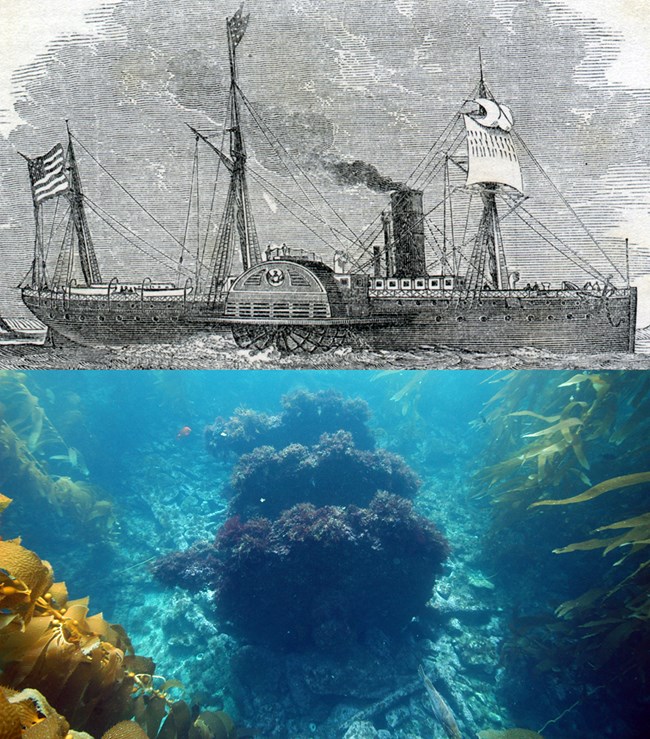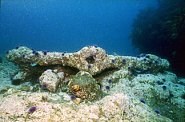
Robert Schwemmer, NOAA The discovery of gold in California in 1848 brought thousands of fortune seekers from the east and around the world. To meet this new demand for travel and resources, shipping and maritime activity increased dramatically. Sailing ships and steamers carried people, food, and supplies up and down the coast and from the eastern United States. A typical voyage from New York to San Francisco brought passengers first to Panama and, once there, it often took over a month for another ship to arrive and take them up the Pacific seaboard. In 1847 two steamship companies connecting New York with San Francisco and the Oregon Territory and charged primarily with the important task of delivering mail were subsidized by the federal government. The Steamship Company and the Pacific Mail Steamship Company acquired many steamships to travel the Panama route. 
Channel Islands National Park Independent steamship companies competed with the mail steamships by promising shorter voyages. To reach their destinations more quickly, ships often risked navigating the narrow Santa Barbara Channel rather than traveling around the Channel Islands. Between 1850 and 1900, at least 33 ships were wrecked in the Channel. One of these ships, the Winfield Scott, still lies beneath the clear waters of Channel Islands National Park. The large steamship sank off the shores of Anacapa Island in 1853. The Winfield Scott was owned by the Pacific Mail Steamship Company. Loaded with over 300 passengers and crew, bags of mail, and $1 million in gold, the steamship departed San Francisco for Panama on December 1, 1853. The next evening Captain Simon F. Blunt chose to pass through the Santa Barbara Channel to save time. The fog was dense, but he knew his course. Believing he had passed the islands, Blunt turned southeast, an unfortunate and tragic miscalculation. At 11:00 pm, the Winfield Scott crashed into a large rock off Middle Anacapa at full speed, striking two holes in the bow. The stern then struck, knocking away the rudder, and the ship began to sink. Captain Blunt sent a boat to find a place onshore for the passengers and ordered everyone on board to abandon ship. The large group was brought to the beaches of Anacapa where they camped for nearly a week. Another ship, the California, saw the smoke from the passenger’s fires and rescued the women. It returned on December 9 and removed the rest of the passengers. The company of the Winfield Scott was left on the island to attempt to recover mail, baggage, furniture, and some of the machinery from the wreck, but there was little hope of saving the ship or of getting it off of the ledge. Over forty years later, Captain Maginn and Colonel Baker of the San Pedro visited the wreck in hopes of salvaging some of the copper, iron, and brass which could bring substantial amounts of money. Some of the ship had to be blasted apart by dynamite. Others returned to the shattered site searching for gold and other “treasure.” 
Robert Schwemmer, Channel Islands National Marine Sanctuary You can explore the watery remains of the Winfield Scott shipwreck, though divers and snorkelers are prohibited by antiquity laws from removing any artifacts. The wreck is listed on the National Register of Historic Places. For more information about the Winfield Scott and other Channel Islands shipwrecks, check out the Channel Islands National Marine Sanctuary Shipwreck Database. Open Transcript Open Descriptive Transcript TranscriptChannel Islands Shipwrecks. Middle Anacapa Island, Winfield Scott, 1853. This steamer was carrying over 500 passengers, mail and gold bullion when it ran aground. Santa Rosa Island, Chickasaw, 1962 With its cargo of children’s toys and general merchandise worth $1.5 million, this freighter grounded during a heavy storm. Santa Rosa Island, Goldenhorn 1892 Heavy fog and strong currents carried this 4-masted sailing bark onto shore with a cargo of Australian coal. San Miguel island, Comet 1911 Sailing in heavy seas and fog with a cargo of lumber, this 3-masted schooner struck a rock and then was driven ashore. Santa Miguel Island, Cuba, 1923 This cargo-passenger steamer ran aground in heavy fog with over 100 passengers and a cargo of silver bullion. Santa Rosa island, Jane. L Stanford Some of the wreckage of this 215-foot, 4-masted barkentine can still be seen at Skunk Point. Santa Rosa Island, Aggi, 1915 Loaded with barley and beans, this 3-masted steel ship was lost on Talcott Shoals during a severe storm. Santa Rosa Island, Crown of England After grounding during heavy fog, a crew of 6 rowed nearly 100 miles to Santa Monica for help. Spirit of America off Santa Cruz island Built in 1943 this ship was used to sweep the Japanese islands of mines during World War II. Cause of sinking is unknown.
Descriptive Transcript00:00:01 00:00:40 Now: Santa Cruz Island, Spirit of America, 1970s. A photo of the vessel and photos of the shipwreck underwater. Words: Built in 1943 this ship was used to sweep the Japanese islands of mines during World War II. Cause of sinking is unknown.
Visit our keyboard shortcuts docs for details
Learn about a some of the approximately 100 shipwrecks that have been documented within the park. The park and the sanctuary protect these shipwrecks as part of our cultural heritage. Open Transcript Open Descriptive Transcript TranscriptChannel Islands Shipwrecks. Middle Anacapa Island, Winfield Scott, 1853. This steamer was carrying over 500 passengers, mail and gold bullion when it ran aground. Santa Rosa Island, Chickasaw, 1962 With its cargo of children’s toys and general merchandise worth $1.5 million, this freighter grounded during a heavy storm. Santa Rosa Island, Goldenhorn 1892 Heavy fog and strong currents carried this 4-masted sailing bark onto shore with a cargo of Australian coal. San Miguel island, Comet 1911 Sailing in heavy seas and fog with a cargo of lumber, this 3-masted schooner struck a rock and then was driven ashore. Santa Miguel Island, Cuba, 1923 This cargo-passenger steamer ran aground in heavy fog with over 100 passengers and a cargo of silver bullion. Santa Rosa island, Jane. L Stanford Some of the wreckage of this 215-foot, 4-masted barkentine can still be seen at Skunk Point. Santa Rosa Island, Aggi, 1915 Loaded with barley and beans, this 3-masted steel ship was lost on Talcott Shoals during a severe storm. Santa Rosa Island, Crown of England After grounding during heavy fog, a crew of 6 rowed nearly 100 miles to Santa Monica for help. Spirit of America off Santa Cruz island Built in 1943 this ship was used to sweep the Japanese islands of mines during World War II. Cause of sinking is unknown.
Descriptive Transcript00:00:01 Visual cue: over a map words read channel islands shipwrecks (v fast) Across a color map, words read: Channel Islands Shipwrecks. Around small islands, blue symbols of boats tilted onto their sides. 00:00:09 Visual cue: close up of Winfield Scott and a drawing of the ships (fast) Now: Middle Anacapa Island, Winfield Scott, 1853. A painting of the ship. Video of divers exploring the wreck. Words: This steamer was carrying over 500 passengers, mail and gold bullion when it ran aground. 00:00:23 Visual cue: Santa Rosa Island, Chickasaw, 1962 (fast) Now: Santa Rosa Island. Chickasaw, 1962. A photo of the shipwreck. Photos of the ship run aground. Words: With its cargo of children’s toys and general merchandise worth $1.5 million, this freighter grounded during a heavy storm.
00:00:40 Visual Cue: Santa Rosa Island, Goldenhorn 1892 (fast) Now: Santa Rosa Island, Goldenhorn, 1892. A photo of the ship and photos of the shipwreck underwater. Words: Heavy fog and strong currents carried this 4-masted sailing bark onto shore with a cargo of Australian coal. 00:00:54 Visual cue: San Miguel island, Comet 1911 Now: San Miguel Island, Comet, 1911. A photo of the cargo ship. Photos of the ship washed up on a beach. Words: Sailing in heavy seas and fog with a cargo of lumber, this 3-masted schooner struck a rock and then was driven ashore. 00:01:10 Visual Cue: Santa Miguel Island, Cuba, 1923 Now: San Miguel Island, Cuba 1923. Photos of the ship and divers exploring the wreck. Words: This cargo-passenger steamer ran aground in heavy fog with over 100 passengers and a cargo of silver bullion. 00:01:23Visual cue: Santa Rosa island, Jane. L Stanford Now: Santa Rosa Island, Jane L. Stanford, 1929. A photo of the ship in a harbor. Video of the wreck. Words: Some of the wreckage of this 215-foot, 4-masted barkentine can still be seen at Skunk Point. 00:01:40 Visual cue: Santa Rosa Island, Aggi, 1915 Now: Santa Rosa Island, Aggi, 1915. A photo of the ship in a harbor. Photos of the shipwreck underwater. Words: Loaded with barley and beans, this 3-masted steel ship was lost on Talcott Shoals during a severe storm. 00:01:53 Visual cue: Santa Rosa Island, Crown of England Now: Santa Rosa Island, Crown of England, 1894. A drawing of the ship. A photo of 2 men examining the wreckage. Words: After grounding during heavy fog, a crew of 6 rowed nearly 100 miles to Santa Monica for help. 00:02:07 Visual cue: Spirit of America off Santa Cruz island
Now: Santa Cruz Island, Spirit of America, 1970s. A photo of the vessel and photos of the shipwreck underwater. Words: Built in 1943 this ship was used to sweep the Japanese islands of mines during World War II. Cause of sinking is unknown.
Visit our keyboard shortcuts docs for details
Naufrágios de Channel Islands Spanish version of the shipwreck video. |
Last updated: November 7, 2018
